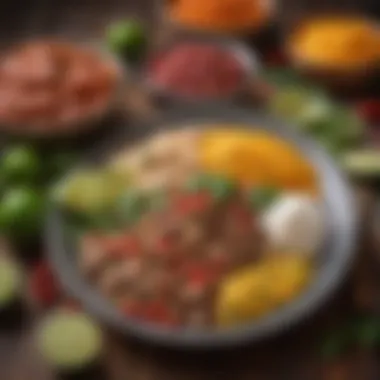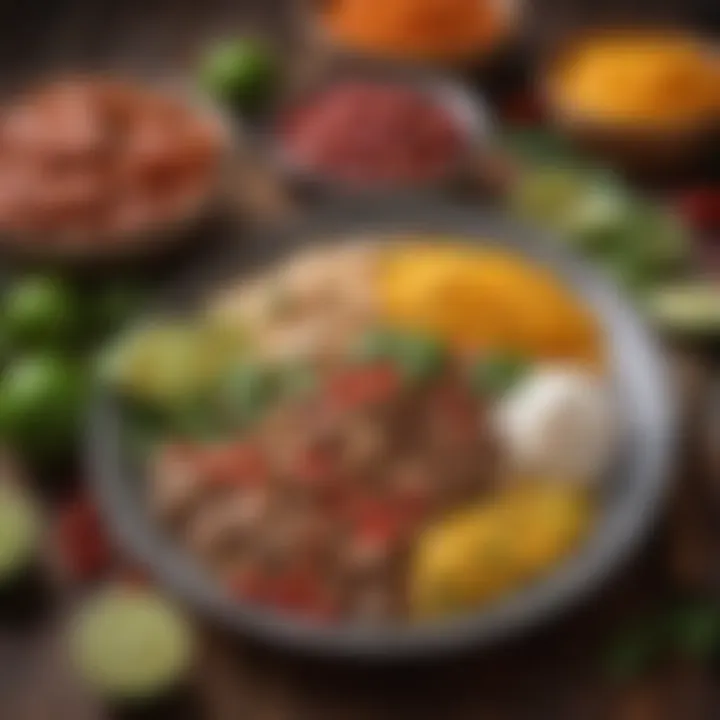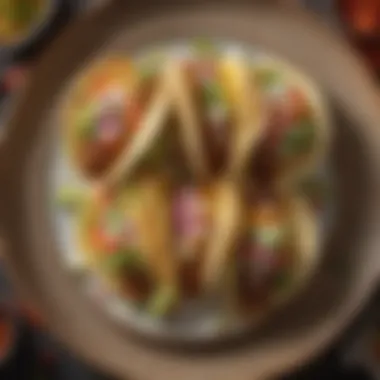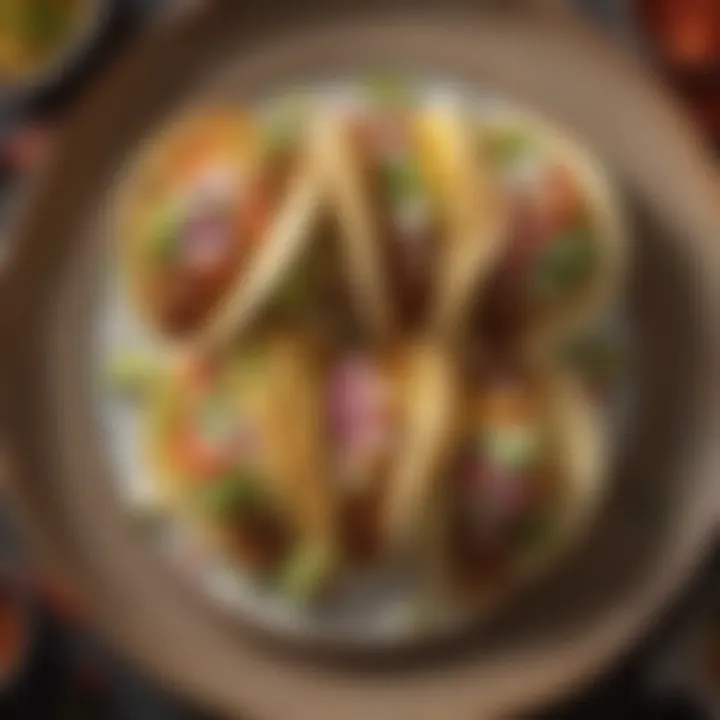Exploring the Rich Flavors of Mexican Cuisine


Intro
Mexican cuisine is a dazzling tapestry of flavors, colors, and textures, rooted in centuries of history and influenced by a mosaic of cultures. It's not just food; it’s an experience to be savored, cherished, and shared. Every bite tells a story that resonates with the heart and soul of a nation. From bustling street markets to sophisticated restaurants, the sheer diversity of dishes showcases both time-honored traditions and modern culinary ingenuity.
This exploration begins with uncovering some of the iconic dishes that stand at the pinnacle of Mexican food. Each dish reflects regional nuances, showcasing the local ingredients and culinary techniques unique to its area. You’ll discover how simple staples can be transformed into a symphony of flavors and aromas that dance on the palate.
As we dive deeper, we’ll embark on a journey through the essential components of Mexican cuisine—think vibrant chili peppers, zesty lime, hearty tortillas, and rich salsas. We’ll also put the spotlight on pivotal recipes, detail the necessary ingredients to recreate them, and even offer insight into those delightful regional variations. Get ready, because we are about to savor the magic of Mexican cooking in all its forms.
"Mexican food is an ever-evolving art form."
In the following sections, we will:
- Delve into the history that gives Mexican food its unique character
- Explore various recipes that exemplify this rich tradition
- Unpack the essential ingredients and where to find the best ones
- Discuss contemporary adaptations that keep the cuisine fresh and exciting
By the end of this culinary exploration, you’ll not only be equipped to appreciate Mexican cuisine deeply but also inspired to incorporate its vibrant flavors into your own cooking. Let’s begin!
Prolusion to Mexican Cuisine
Mexican cuisine stands as a vibrant tapestry woven from centuries of rich history, cultural influences, and culinary techniques. This multifaceted subject not only delights the palate but also offers insight into the country's diverse heritage. As we embark on this exploration, we'll uncover the significance of the elements that shape Mexican food, revealing its role in both everyday life and special occasions. The importance of understanding Mexican cuisine lies in its ability to connect us to traditions, fostering appreciation for its intricate flavors and methods that have evolved over time.
Historical Background
Diving into the historical aspects, it's clear that Mexican cuisine is not an isolated phenomenon. Its roots extend deep into pre-Columbian civilizations, where indigenous peoples cultivated crops that remain staples today, such as maize, beans, and squash. The arrival of the Spanish in the 16th century marked a turning point, introducing new ingredients like cattle, rice, and spices. These two worlds collided, leading to a remarkable fusion that defined Mexican culinary practices.
In modern times, the historical journey continues to influence how dishes are prepared and celebrated across the region, highlighting the balance between tradition and innovation.
Culinary Philosophy
The culinary philosophy of Mexican cooking resonates with the very essence of local culture and community. Meals are often viewed as communal experiences, emphasizing the importance of sharing and gathering at the table. This ties closely to the concept of "sabor" or flavor, which goes beyond taste to encompass aroma, appearance, and the overall feel of the dish. The preparation of food is considered an art, with techniques passed down through generations, often shaped by regional preferences.
Adventurous use of ingredients is also a hallmark. Chefs and home cooks alike are encouraged to experiment, mixing and matching flavors, which leads to a kingdom of possibilities right in the kitchen. The passion for culinary tradition is evident in annual festivals and family celebrations where ancestral recipes are dusted off and presented with pride.
"In Mexico, food is more than just sustenance; it’s a vibrant expression of culture and identity."
By examining both the historical background and culinary philosophy, readers will gain a deeper appreciation for the flavors and techniques that make Mexican cuisine one of the most dynamic and cherished in the world.
Essential Ingredients of Mexican Cooking
When we talk about Mexican cuisine, the heart of the conversation often leads us to its essential ingredients. These components are not just add-ons; they serve as the backbone of every dish, bringing flavor, character, and history to the table. From the colorful chiles that bring heat to the mellow richness of beans and the versatile nature of corn, these ingredients connect a chef's hands to generations of culinary practice. They are the symbols of tradition, the whispers of culture, and the reasons why Mexican food enchants palates worldwide.
Varieties of Chiles
Chiles are the blazing stars in the galaxy of Mexican cooking. They come in various shapes, sizes, and heat levels, ranging from the mild poblano to the fiery habanero. Each type embodies its own distinct flavor profile. Not only do chiles offer heat, but they also provide complexity, enhancing a dish rather than simply making it spicy. For instance, the smoky flavor of chipotle is essential in many sauces and marinades, while the fresh bite of jalapeño adds a lively zing to salsas. It’s like having a spice cabinet locked within the garden.
Chiles are fundamental in creating authentic mole sauces, where they blend perfectly with chocolate to craft rich and layered flavors. Moreover, the act of roasting chiles enhances their flavors significantly. Just a bit of heat brings out their natural sweetness and deepens their essence, a testament to how simple techniques can yield bold results.
Traditional Staples
Corn
Corn is not merely a staple; it’s a vital part of the Mexican identity. It has been a significant crop for centuries, often seen as a symbol of life and sustenance. From which tortillas are made, to tamales, or even elotes, corn serves as the crucial base for countless creations. The nixtamalization process, where corn is soaked in lime water, boosts its nutritional value and enhances its flavor.
The unique feature of corn lies in its versatility. You can enjoy it fresh, dried, or in various processed forms, giving it the broadest range of culinary applications. Corn tortillas are celebrated for their ability to hold fillings without falling apart, making them a popular choice for tacos. However, relying heavily only on corn may limit the encounter with other vital grains.
Beans
Beans are another pillar of Mexican cooking. They are nutrient-packed, providing protein and fibers. Varieties like black beans, pinto beans, and refried beans each bring something different to the table. Black beans are known for their creamy texture and depth of flavor, making them beloved in many traditional dishes.
The benefit of beans extends beyond their sustenance. Their economical nature makes them accessible to everyone – a boon for families on a budget. However, one must be mindful of overcooking, as this can ruin their texture and appeal.
Rice
An often forgotten hero in Mexican food, rice complements countless meals and serves as a blank canvas for flavors. Mexican rice can be found in various styles, typically cooked with tomato to achieve a vibrant color and taste. The fluffy texture makes it a welcome addition, particularly when paired with spicy dishes.
But rice is not just a filler; it can stand out beautifully on its own, especially when garnished with herbs or beans mixed in. Nonetheless, poor quality or overcooked rice can detract from the overall dish, which is why selecting the right kind and following through with proper cooking techniques is paramount.
Herbs and Spices
Herbs and spices breathe life into Mexican dishes. Fresh cilantro, for example, brings brightness to a salsa, while oregano adds warmth to stews. Spices like cumin introduce earthy undertones that are known for transforming a simple dish into something memorable.
The compelling dance of these flavor enhancers allows for vibrant profiles, making each bite an experience. Their roles are not just to season; they embody the traditions of various regions, showing how nature’s gifts intertwine with cultural history.
In essence, understanding these essential ingredients lays the groundwork for appreciating Mexican cuisine. They tell a story of land, culture, and family connections through culinary artistry.


Regional Specialties
Regional specialties play a pivotal role in the rich tapestry of Mexican cuisine. They give a sense of place and identity to food—each region’s unique topography, climate, and cultural influences create distinct culinary narratives. From the sophisticated sauces of Oaxaca to the coastal seafood delights of Veracruz, experiencing regional dishes is akin to traversing the vast landscapes of Mexico without ever leaving your seat. Flavor profiles and cooking techniques vary, providing endless opportunities for the adventurous palate. Exploring regional specialties enhances our understanding of the cultural significance attached to food, offering a deeper connection to the traditions that shape Mexican culinary practices.
Central Mexico Delicacies
Street Tacos
Street tacos are perhaps the quintessential Mexican food experience. Whether enjoyed from a bustling vendor or a cozy family-owned taquería, these handheld delights represent the heart and soul of Mexican street food culture. A hallmark characteristic of street tacos is their versatility; from carnitas to barbacoa, the choice of filling seems endless. Their popularity stems not only from taste but also from the sheer convenience they offer, making them accessible for anyone on the go.
What sets street tacos apart is the simplicity in their preparation. Generally served on soft corn tortillas, they are garnished with fresh ingredients like cilantro, onions, and a drizzle of lime juice. The combination packs a flavorful punch alongside the chosen filling. A unique feature of street tacos is how they bring people together; friends huddled around a taco cart under the glow of streetlights share stories as they enjoy savory morsels, creating lasting memories.
However, one need to keep in mind that street food varies by vendor, which can lead to inconsistent experiences, with some taco stands standing out while others may disappoint.
Mole
Mole is another central Mexican delicacy renowned for its complex layers of flavor. The beauty of mole lies in its rich sauce, which combines a multitude of ingredients including chiles, spices, nuts, seeds, and often, chocolate. This intricate dish encapsulates the merging of indigenous and colonial influences, embodying a fascinating culinary history. Traditionally served over meats or tamales, mole has a distinct characteristic of being both sweet and savory, a duality that resonates with many food enthusiasts.
The prominence of mole in Mexican cuisine serves a beneficial role, as it symbolizes celebration and festivity. It's often prepared for special occasions, such as weddings or holidays, making it a staple in gatherings. Its unique feature is the time and effort required in its preparation; traditional recipes can take hours and sometimes even days to perfect.
The downside, however, is that the complexity of mole can sometimes prove to be intimidating for home cooks wishing to replicate its nuanced flavors effortlessly.
Coastal Flavors
Ceviche
Ceviche stands out as a refreshing coastal dish that showcases the bounty of the sea, particularly along Mexico's Pacific and Caribbean coasts. Made primarily with fresh fish or seafood marinated in lime juice, this dish is characterized by its vibrant flavors and bright presentation. The acidity of the lime "cooks" the protein, a process complemented by an array of ingredients like tomatoes, onions, and cilantro.
A key attraction of ceviche is its health-conscious appeal; it is often low in calories and packed with protein and omega-3 fatty acids, making it an enticing option for many. Additionally, ceviche is versatile—there are countless variations across different regions, swapping fish for shrimp, octopus, or even a medley of seafood.
One downside, however, is the necessity for extremely fresh ingredients. Ceviche can be tricky if made with inferior seafood, as it requires high-quality fishing to ensure safety and desired flavor.
Seafood Tacos
Seafood tacos bring the fresh flavors of the ocean right to your plate. This delicious dish typically features a variety of fillings, from shrimp and fish to octopus, drizzled with tangy sauces and topped with crunchy cabbage and avocado slices. The primary characteristic that sets seafood tacos apart is their seasonal ingredient focus, often highlighting what's freshly caught.
They provide a beneficial choice for those seeking lighter fare that's still bursting with flavor. Many food lovers adore seafood tacos for their crunchy yet soft texture and the fragrant burst of lime in every bite. The uniqueness of seafood tacos is their inherent adaptability; they can be effortlessly tailored with diverse toppings and salsa variations.
However, this dish’s reliance on fresh seafood poses a challenge—availability can fluctuate by season, which might limit options for those looking to enjoy this specialty throughout the year.
Northern Mexican Favourites
Carne Asada
Carne Asada, or grilled beef, is a staple in Northern Mexico, and it’s hard to overstate its importance. Known for its intense flavor, carne asada is typically marinated with lime juice, garlic, and various spices—providing a piquant kick that makes it a favorite choice for barbecues and gatherings. The primary characteristic that endears carne asada to so many is the communal aspect; it often serves as the centerpiece of family feasts, encouraging togetherness and celebration.
The uniqueness of this dish lies in its preparation method; grilling over open flames imparts a delightful smoky flavor that enhances the natural taste of the beef. It's also adaptable, as it can be sliced into tacos, burritos, or enjoyed on its own with sides of beans and rice.
One downside is the variations in quality depending on the cut of meat used; a poorly chosen cut can lead to dryness, overshadowing the dish's full flavor potential.
Burritos
Burritos are often thought of as the ideal on-the-go meal, perfectly encapsulating the spirit of Northern Mexican cuisine. This dish consists of a flour tortilla wrapped around a delectable filling of rice, beans, meats, and a myriad of toppings. The easy-to-manage design is one of its standout features, making it a convenient choice for busy lifestyles.
The flexibility of burritos offers a multitude of flavor combinations, allowing for customization that appeals to many. The unique aspect here lies in their portability; burritos can be enjoyed anywhere—from home kitchens to food trucks, making them popular among various demographic groups.
A disadvantage to note is the potential for burritos to become unwieldy if overstuffed, leading to messy meals that may not do justice to the carefully constructed ensemble of flavors.
By understanding these regional specialties, readers can not only appreciate the variety found in Mexican cuisine but also gain inspiration for their culinary endeavors at home.
Popular Mexican Dishes
When one thinks of Mexican cuisine, certain dishes inevitably come to mind. These are the flavors that speak not just to the palate but also to the heart and culture of Mexico. The significance of Mexican dishes extends far beyond simple sustenance; they encapsulate stories, traditions, and the artistry of cooking that resonates with people across the globe.
Tacos: A Versatile Icon
Tacos hold a venerated space in the world of Mexican cuisine. They are more than just a meal; they symbolize a cultural movement that embraces creativity and personalization. The beauty of tacos lies in their versatility.
Types of Tacos
Tacos can come in an array of forms, depending on the ingredients and the method of preparation. You have your corn soft tortillas, which showcase the authentic taste of Mexico, while flour tortillas cater to a wider audience, especially in Northern regions. The famous "taco al pastor", influenced by Lebanese shawarma, introduces succulent marinated pork layered between piquant pineapple slices.


This variety is a major draw for food lovers, as it allows for endless experimentation with fillings ranging from grilled meats to roasted vegetables. Tacos not only satisfy hunger but also urge diners to engage with their meal.
Regional Variations
Regional variations of tacos contribute significantly to their popularity. In Jalisco, for instance, you'll find "tacos de birria" that will ignite your taste buds, while in the Yucatán, "tacos de cochinita pibil" offers an entirely different flavor profile with rich, slow-cooked pork. These differences reflect local ingredients and cooking methods, showcasing the rich tapestry of Mexican culinary traditions.
Local variations can be a double-edged sword; while they enrich the culinary experience, they might also overwhelm those new to Mexican food.
Enchiladas: Layers of Flavor
Enchiladas are a delightful way to experience a harmonious blend of flavors and textures. These rolled tortillas, filled with an enticing mixture of meats, cheese, or veggies, and then topped with a savory sauce, offer a rich experience. The sauces vary dramatically; from the deep, roasted richness of a red chili sauce to the bright lime and cilantro notes in a green sauce. This layering not only brings depth but also a beautiful visual appeal to the dish, making it a go-to choice for gatherings.
Tamales: Tradition Wrapped
Tamales are a quintessential Mexican dish, often wrapped in corn husks and steamed to perfection. Their significance expands beyond taste; they are a symbol of tradition that often brings families together.
Sweet vs. Savory
Dividing tamales into sweet and savory varieties reveals much about regional preferences and seasonal ingredients. Sweet tamales, sometimes made with cinnamon and raisins, offer a delightful dessert option. On the flip side, savory tamales embrace meats, cheeses, and even salsas. Understanding the choice between sweet and savory tamales allows one to appreciate the versatility and richness inherent in Mexican cooking. Each has a unique appeal; sweet tamales might trigger memories of festive occasions, while savory options feed into more everyday meals, creating a connection between the eater and their cultural roots.
Salsas and Dips
No exploration of Mexican food is complete without considering the range of salsas and dips that complement these dishes. From vibrant pico de gallo to creamy guacamole, each dip provides an explosion of flavors that enhance the eating experience. Salsas are crafted from fresh ingredients, highlighting local produce, which makes their taste undeniably fresh. They serve not just as condiments but as essential companions that can elevate even a simple taco to new heights.
The essence of Mexican cuisine expresses joy and unity amongst families and friends. No meal is merely a meal; it’s a celebration.
In summary, popular Mexican dishes represent both culinary innovations and age-old traditions, creating a bridge between past and present, local and global. Embracing these dishes means not just savoring their flavors but also understanding their deeper meanings within Mexican culture.
Techniques in Mexican Cooking
Understanding the techniques in Mexican cooking is akin to opening a treasure chest of flavors. These methods do not just prepare food, they tell a story, rooted in history and cultural significance. Each technique plays a vital role in enhancing the flavor profile of dishes, preserving traditional methods while infusing modern touches. This nuanced approach to cooking is what makes Mexican cuisine both diverse and universally appealing.
Masa Preparation
Masa, the foundation of many Mexican dishes such as tortillas and tamales, is more than just corn dough. Its preparation is essential for achieving the correct texture and flavor that characterize authentic Mexican cooking. The process starts with nixtamalization, where dried corn is soaked and cooked in an alkaline solution, often limewater. This crucial step not only softens the corn but also enhances its nutritional value and flavor.
The masa must then be kneaded into a smooth, pliable dough, which can then be transformed into various shapes, from flat tortillas to dumplings. One key point to remember is that the freshness of the masa is directly linked to the quality of the dish. Using freshly ground masa yields a richness that can elevate even the simplest taco.
To make masa at home, you can follow these steps:
- Start with dried corn.
- Cook it in a solution of water and lime for about two hours.
- Rinse, then grind into a fine dough.
- Form it into whatever shape your dish requires.
Roasting and Toasting
Roasting and toasting are techniques that enhance flavors, particularly in spices and vegetables. When peppers are roasted, their skins blister, adding a smoky element that tightens the flavor. This technique is most often applied to various chiles, which are crucial in Mexican dishes. A roasted jalapeño, for example, will lend a deeper, richer flavor compared to its raw counterpart.
Toasting spices like cumin or coriander seeds in a dry skillet releases essential oils, creating a more profound aroma and taste. It’s a simple step but can turn the ordinary into extraordinary. This method can also be applied to nuts and seeds, further adding texture and flavor components to dishes.
Some practical tips include:
- Use a cast-iron skillet for even heat distribution while toasting.
- Monitor closely to prevent burning; a minute or two can make a big difference.
- Pair roasted vegetables with fresh herbs to bring balance to the dish.
Slow Cooking Methods
Slow cooking is a hallmark of Mexican cuisine, allowing flavors to meld and deepen over time. This technique is particularly common in dishes like barbacoa or mole, where the proteins become tender and absorb all the spices and aromatics added during the process. The essence of slow cooking is patience; it’s about letting time do the hard work.
Utilizing a slow cooker can simplify this process, giving a modern twist to traditional techniques. It's a method that requires minimal supervision; just toss in your ingredients, set it, and let it work its magic. However, for those seeking a more traditional approach, consider using a Dutch oven or a clay pot, which are well-suited for achieving that slow-cooked perfection.
When employing slow cooking:
- Use tougher cuts of meat, like beef chuck or pork shoulder, as they break down beautifully.
- Make sure to check the moisture levels; adding stock or water is key for preventing dryness.
- Infusing flavors early in the cooking process can elevate your dish to new heights.
"Good cooking is when you make something that people enjoy. Great cooking is when you make something that people will remember."
Cultural Significance of Mexican Cuisine
Mexican cuisine is not just about food; it’s a rich tapestry woven with history, culture, and deep-rooted traditions. Through every dish, a story is shared, reflecting the diverse influences that have shaped this vibrant culinary landscape. The cultural significance of Mexican food extends beyond the flavor; it embodies the very essence of community, identity, and heritage.
Mexican gastronomy also brings people together. Meals often serve as a catalyst for gatherings, encouraging a sense of belonging among families and friends. In modern times, whether at celebratory events or casual dinners, the act of sharing food has become an integral part of friendships and family bonds. One could say it’s the glue that holds social interactions together.
Additionally, traditional Mexican dishes often symbolize specific regional identities. Each region boasts unique ingredients or cooking styles that set it apart—like coastal recipes famed for their seafood, while mountainous areas lean on hearty meats and grains. This regional diversity also mirrors the myriad ethnic backgrounds within the country, creating a rich palate.


The importance of cultural significance can be encapsulated in several key elements:
- Identity: Each family may have signature dishes that define their lineage, passed down through generations.
- Traditions: Festivals and ceremonial gatherings revolve around food, celebrating seasonal changes and important life events.
- Heritage: Many cooking methods and recipes date back centuries and are closely connected to indigenous cultures.
"Mexican cuisine is more than just a source of sustenance; it’s a living cultural expression that fosters connection, understanding, and respect for traditions."
Understanding this cultural significance enriches one's appreciation of individual dishes, turning every bite into a powerful reminder of its origins.
Festivals and Celebrations
Mexican festivals, famed for their color and joy, are inherently tied to food. They serve as grand displays of community and tradition, where the culinary arts take center stage. One of the most well-known celebrations is Día de los Muertos (Day of the Dead). During this festival, families create altars filled with favorite dishes of their deceased loved ones, such as pan de muerto (a sweet bread) and tamales.
Food here is not consumed just for taste; it embodies remembrance and honor. Other celebrations like Cinco de Mayo showcase local delicacies, allowing communities to come together and exchange their culinary heritage. The vibrant, festive atmosphere is palpable, with music, dancing, and, of course, plenty of food to share, you can see how deeply ingrained these practices are in Mexican culture.
Family Traditions
Family traditions surrounding food often intertwine with the festivities, creating an unbreakable bond over shared meals. Mexican households often have cherished recipes seen as heirlooms passed down, each generation adding their unique twist while keeping the essence intact. Sunday dinners, for example, become a special occasion where extended families gather to indulge in favorites like mole or pozole.
Cooking together is another way families forge connections. You’ll find families engaged in the production of tamales or tortillas, often involving the youngest to teach them age-old traditions. This hands-on approach ensures that cultural knowledge and culinary skills don’t fade with time.
Furthermore, meals served during special occasions often feature particular dishes that signify blessings or good fortune. Such customs instill values of gratitude and abundance, reminding families of their roots.
In essence, enjoying Mexican food isn’t just about taste; it provides insights into the life, history, and values of those who prepare and consume it, making every meal a familial celebration.
Contemporary Trends in Mexican Food
In the ever-evolving culinary world, Mexican cuisine stands tall, adapting yet keeping its roots intact. The contemporary trends in Mexican food reflect a dynamic interaction of traditional flavors with global influences. These trends are not just fads; they showcase how chefs and home cooks alike are merging time-honored techniques with innovative ideas. This section aims to illuminate the significance of these trends within the context of Mexican cuisine and the broader gastronomic landscape.
Fusion Cuisine
Fusion cuisine has made waves in the gastronomical communities across the globe, and Mexican food is no exception. This beautifully chaotic culinary style invites a mingling of cultures, resulting in dishes that reveal surprising harmonies and contrasts between flavors. For instance, you may find tacos filled with Korean barbacoa or enchiladas smothered in a Thai curry sauce. Each bite becomes a celebration of cultural exchange, creating exciting opportunities for diners.
The trend also appears in urban settings, where food trucks and casual eateries showcase hybrids like the banh mi taco, a combination of Vietnamese and Mexican traditions. This playful blending results in dishes that appeal to adventurous palettes looking for something beyond the norm.
- Benefits of Fusion Cuisine:
- Opens doors to culinary creativity.
- Engages younger audiences and food enthusiasts.
- Bridges cultural gaps and encourages dialogue through food.
While fusion is delightful, it is imperative to tread carefully. The essence of the original cuisine should not be lost in translation; the key is respecting traditional elements while inviting new ideas. Striking that balance is what distinguishes successful fusion from mere novelty.
Health Conscious Adaptations
As society becomes increasingly health-conscious, Mexican cuisine has adapted to reflect these changing views. Classic dishes are being revisited, with healthier alternatives being introduced into the mix. For example, traditional fried taquitos can now be found baked, and loads of greens are added to enhance nutritional value without losing flavor.
One prominent shift is towards using organic, locally-sourced ingredients. Home cooks and chefs are diving deep into farmers' markets, creating vibrant salsas and dishes that accentuate the freshness of seasonal bounty. Another change is the rise of plant-based options, where meat substitutes might feature in classic recipes, allowing a broader audience to enjoy the flavors of Mexico.
- Key Considerations:
- Retain the authentic flavors that make the dishes beloved.
- Educate consumers on the potential benefits of ingredients.
- Cater to diverse dietary needs, including gluten-free and vegan options.
Adapting beloved recipes for modern dietary preferences not only satisfies health-conscious consumers but also revitalizes the culinary landscape. By combining tradition with innovation, Mexican cuisine finds itself at the forefront of contemporary food discussions.
"Tradition is not the worship of ashes, but the preservation of fire."
Ending: Embracing the Flavors
As we turn the final page on this culinary journey through Mexican cuisine, it’s clear that the flavors and traditions woven into each dish carry an important weight in the hearts of those who savor them. Embracing these flavors isn’t merely about enjoying food; it’s a doorway to understanding the rich history and vibrant culture that shapes Mexico. Many dishes tell stories of resilience, celebration, and family. They link the past to the present, bridging generations with each bite.
Bringing Mexico Home
To truly embrace these flavors, one doesn't have to travel to Mexico. Instead, it's about bringing these exquisite tastes into your own kitchen. The process of preparing traditional meals can be a fulfilling experience, allowing you to connect with the ingredients and techniques that define this delectable cuisine.
When cooking Mexican food at home, consider starting with some essential recipes like tacos or enchiladas. Each dish offers versatility, allowing for personal touches that reflect your taste while staying true to their roots. Gather some core ingredients like fresh corn tortillas, black beans, and various chiles to recreate authentic textures and flavors.
Importantly, engaging in this culinary practice can be an excellent way to foster connection with friends and family. Make it a point to share meals, swapping stories about family recipes, perhaps igniting a spark of tradition in younger generations. After all, food has a unique way of bringing people together.
Encouraging Exploration
Exploring Mexican cuisine goes beyond just preparing food; it’s an invitation to discover new flavors, techniques, and cultural nuances. Don’t shy away from experimenting with different regional specialties, from the freshness of ceviche hailing from coastal towns to the robust mole sauces often crafted in Oaxaca.
Traveling through local markets can also provide valuable insights. Look for uncommon ingredients, take a chance on unfamiliar herbs or spices. Being curious can lead you down unexpected paths that enhance your understanding of this rich culinary landscape.
Moreover, engaging with the global community of food lovers on platforms like Reddit or sharing experiences on Facebook can foster discussions about food practices and recipes.
Final Thoughts
In the end, embracing the flavors of Mexican cuisine is not just about the food; it’s about appreciating the culture it represents. As we incorporate these elements into our everyday culinary practices, we are reminded of the stories, traditions, and profound connections that food influences.
"Food is not just about sustenance; it’s about sharing parts of ourselves through vibrant flavors and culinary traditions."
So, gather your loved ones, set the table, and make room for the rich diversity of flavors that await in every Mexican meal.







